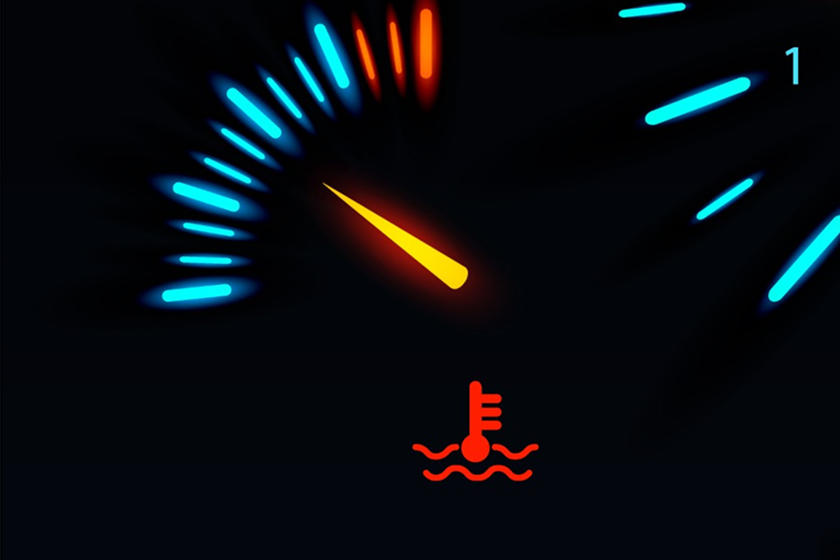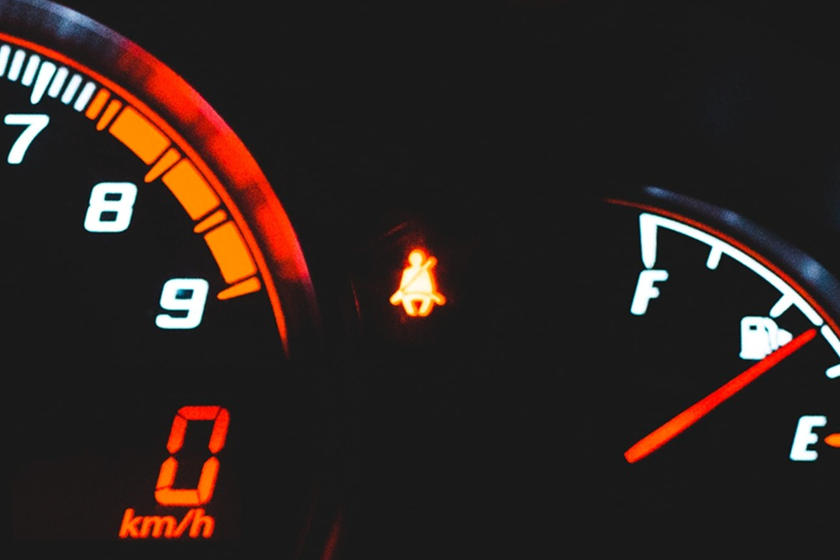What Does It Mean When All Dash Lights Come on
What the various warning symbols mean
Read in this article:
- Car Dash Symbols and Their Meaning
- Engine Temperature Warning
- Check Engine Warning
- Glow Plug Warning
- Diesel Particulate Filter Warning
- Battery Charge Warning
- Power steering warning
- Oil pressure warning
- Brake system warning
- Door/trunk/hood warning
- Seatbelt warning
- Tire pressure sensor warning
- Traction-control warning
- Low fuel warning
- FAQs
We live in a world rife with symbolism, from traffic lights and store signs all the way through to dashboard lights and hand gestures. The meaning behind these symbols is something we often learn over time but, occasionally, we need a little help with the finer details. It might sound like a drag to read through your user manual when all you really want to do is get behind the wheel of your new car and go for a drive. However, the warning lights on your car dashboard are there for a reason, and understanding car dashboard symbols and their meanings could be the difference between an enjoyable ride and a gut-wrenching breakdown.
Car Dash Symbols and Their Meaning
While all vehicles differ slightly, most share a common set of dashboard symbols and signals. dash These lights on the car dash are categorized by their color - blue or green simply displays that the feature is active; yellow or orange cautions drivers that a system needs checking soon; and red car dash symbols warn that something is critically wrong.
Here is a list of all the common car dashboard warning lights, their meaning, and a visual aid:
Engine Temperature Warning
One of the more critical vehicle warning lights, this symbol will usually only light up after you have been driving for some time. While the immediate concern is simply the temperature, the actual cause could be any number of factors. These include low engine coolant levels, a leaky radiator, clogged pipes, or even a blown gasket. Regardless of the cause, it is imperative that you safely pull over at the earliest opportunity and turn the vehicle off. Continuing on while this warning is displayed could lead to a catastrophic failure of the engine and permanent damage. If you can't figure out the problem, you should get to a workshop as soon as possible. If there are none nearby, rather call a tow service than try to get there on your own.
 freepik.com
freepik.com
Check Engine Warning
As one of the yellow dash indicator lights, this warning is not as critical as the aforementioned one. However, no potential problem with the engine should ever go overlooked for long. Even if it is simply a fault with the sensor or car panel lights, you should get to a mechanic at your earliest convenience. Engine damage can lead to hefty repair or replacement bills.
 unsplash.com
unsplash.com
Glow Plug Warning
This is one of the lesser-known dashboard warning symbols, since it is only found on diesel vehicles. The engines found in these cars rely on different mechanics, including glow plugs, which are used to regulate temperature and pressure. If left unchecked, a problem with the glow plugs can lead to early/late combustions, which manifests as a rough engine sound and a drop in fuel efficiency.
Diesel Particulate Filter Warning
The DPF is another of those niche symbols that are found only on diesel-powered vehicles. It signifies a problem with the filter, which may be blocked or damaged. This leads to billows of smoke from the exhaust, but can also cause engine damage if left unchecked.
Battery Charge Warning
While this is technically one of the critical red car indicator lights, it does not require instantaneous shutdown of the vehicle. In fact, that may lead to more trouble. Instead, you should turn off all unnecessary electronics, such as your stereo or air conditioning. This is because the engine and alternator are not functioning properly to recharge the battery, and any additional drain could leave you stranded the next time you try to turn the ignition. Unfortunately, many essential safety and driver-assistance systems also need power and may not get enough no matter what you do. You should make sure to come to a stop at a gas station or somewhere that you may be able to get a jumpstart in the event that your battery is dead.
 unsplash.com
unsplash.com
Power steering warning
A problem with the power steering may stem from either mechanical or electrical sources. Naturally, this light only appears on vehicles equipped with such a system, but that includes most modern cars produced in the USA. You'll notice that the steering wheel feels a lot heavier than usual, since the failing system actually works against you. It is advised that you pull over as soon as possible. It may simply be that your power steering fluid needs refilling, especially if it has sprung a leak, but you may need professional help, too.
Oil pressure warning
Automobiles rely on a careful balance of multiple liquids to keep all the parts working, and problems with any of them can be serious. This light rears its ugly head when the oil pump isn't creating enough pressure. Common causes include a leak or fault pump, as well as low oil levels (which is why you should your motor oil levels regularly - read here for an easy 'how to' guide). The latter is easy to fix - simply top up the oil. However, if the problem persists, consult your handbook or seek a mechanic's help.
 freepik.com
freepik.com
Brake system warning
Another critical system, improperly functioning brakes can cause serious problems. If you're lucky, the issue may simply be that you forgot to disengage the parking brake before heading off. However, it could also be that your brake fluid is low or that the brake pads are worn to the point where they no longer function reliably. Alternatively, it could be something more complicated. The best thing to do is call roadside assistance or a tow, since driving is inadvisable. Let the professionals help you out.
 Pexels.com
Pexels.com
Door/trunk/hood warning
While it may not sound overly critical that your doors are not properly sealed or that you left your trunk open, it can be very dangerous, especially for other motorists or pedestrians. You certainly wouldn't want your passenger door to swing open when you come to a stop and slam into a cyclist. Normally, you can tell if one of these hatches is open, but sometimes it is simply a case of them being slightly loose. Often this also means interior lights remain on, and over time, will drain the battery. In any event, you should definitely recheck all hatches are closed before getting underway, or leaving your car.
 unsplash.com
unsplash.com
 unsplash.com
unsplash.com


Seatbelt warning
This may not seem like a "red" issue, but making sure your seatbelt is properly fastened before driving can actually be the difference between life and death. It doesn't matter if you plan to drive 100 miles or 10 meters. Almost all modern cars include this sensor, and many also add an audible alert. In some cases, the sound becomes increasingly aggravating to the point where it is simply easier to do as you are told.
 unsplash.com
unsplash.com
Tire pressure sensor warning
Though it is a less critical alert, the TPMS should not go ignored for long. As tire pressure drops, handling decreases and braking becomes less controlled. Generally, the light does not turn red in the event of a major pressure decrease, so there is no way to tell if it is safe to drive without risking a major blowout. You should either pull over and check the pressure yourself, if you have a kit, or else find a gas station to inflate the tires in question and patch any leaks.
 unsplash.com
unsplash.com
Traction-control warning
Another seemingly innocuous warning, this symbol lights up when the tires are not gripping the road as well as they should. Most commonly, this will occur during rainy or snowy weather conditions. More confident and adventurous drivers may choose to deactivate the built-in traction system in their cars, in which case, the light can be ignored. However, if you haven't done so and the light continues to show, it means you should get the system checked, since it is not working correctly, if at all.
Low fuel warning
A symbol we all dread, especially on a long road trip or when your wallets are especially light, this ominous yellow indicator simply lets you know when your fuel tank is running low. Needless to say, you shouldn't ignore it for too long, unless you enjoy long hikes with a fuel canister in hand. Most modern cars will give you more than enough warning to find a gas station, but if it's been on for a while, you better not dally! After all, breaking down due to driver negligence is a finable offense, and you certainly won't need the extra cost.
FAQs
Why are the dashboard lights different colors?
In general, the color of each symbol denotes the severity of the problem. Green or blue lights are not actually problems, but rather serve to let you know that a system is active. This helps to remind you that your lights are on, for example. Orange symbols serve to caution you that one or more of your car's systems are not functioning the way they should. While the risk of serious damage may not be serious immediately, you should get the system in question checked soon. Red symbols should never be ignored. These denote critical alerts or possible system failures and should be handled as soon as humanly possible.
What is the most dangerous dashboard light?
This is debatable since every red light should be taken seriously. However, the engine temperature light is the most likely to signify that serious or irreparable damage will occur if no immediate action is taken.
Why are my dashboard lights not working?
If your console shows no lights upon turning your key in the starter, or after ignition, then there is a good chance you have blown a fuse. While this may not seem like a big deal, you should replace it as soon as possible since many of these lights are important while driving. If this still doesn't solve the problem, see a mechanic or auto electrician, as there may be a larger electrical problem.
How do you reset your dashboard lights?
Occasionally, even after a problem has been solved, the dashboard light associated with it may still be active. In this event, you need to reset the system. You can do this by opening the hood of the vehicle and loosening the nut around the negative terminal of the battery. Then, completely remove the battery cable and leave it for around ten minutes to ensure the onboard computer resets. Afterwards, simply reconnect the battery and tighten the nut properly. If the light is still active, you may need to have the related system rechecked for faults.
Was this article helpful?
Please rate it
What Does It Mean When All Dash Lights Come on
Source: https://carbuzz.com/car-advice/a-complete-guide-to-warning-lights-on-your-car-dashboard